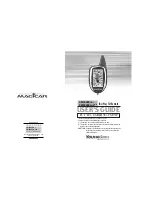
46
multi
MAUS
Evolution of the ROCO locomotive mouse – the
multi
MAUS
The
multi
MAUS
combines the functionality of the legendary Lokmaus with the convenience of a full-
blown digital control centre. Whether you use the
multi
MAUS
only as a handy speed controller or want
to do extensive programming for your locomotive decoders and turnouts, the clear design combined
with the simple operation makes the
multi
MAUS
a benchmark for digital model railway controls.
Our aim was to design this locomotive mouse so that it can be operated intuitively. Even the many
new functions of this 3rd generation locomotive mouse can be easily controlled. In this manual, we
will show you what the
multi
MAUS
can do.
This manual it is divided into several parts to make the contents clearer. That means a user who only
wants to play with the
multi
MAUS
does not have to read through the entire manual; the fi rst part is
enough.
This fi rst part of the manual deals with the most important basics for connecting and operating
the
multi
MAUS
. Users who want to use the many options of
multi
MAUS
for programming will fi nd
everything they need to know in the second part. The third part deals with special topics related to
digital model railways. A glossary explains some important basic terms that you may see again and
again when dealing with digital model railways.
We hope you enjoy reading this manual and, of course, using the
multi
MAUS
!
Your Modelleisenbahn GmbH
The
multi
MAUS at a glance
The concept
• Ergonomic shape for one-hand operation
• Large backlit LC display
• Easy adjustment of speed and driving direction of the locomotive using the rotary knob
• Latching of the 0 position of the rotary control
• Multiple languages
• Compatibility with other DCC- / NMRA-compatible controls
• The ROCO digital system is can be expanded to include up to 31 input devices such as addi-
tional locomotive mice or
multi
MAUS
units, RouteControl, etc.
• Future updates via RS485 and ROCOMOTION (X-BUS)
The options
• Management of 9,999 locomotive addresses, optionally using a locomotive library or locomotive
address
• Alphanumeric locomotive name display with locomotive database for 64 entries or locomotives
• Locomotives can be controlled individually for each locomotive with 14, 28 or 128 speed steps
• Control of light and 20 additional functions for locomotives
• Control of up to 1,024 turnout addresses
•
Writing of confi guration variables (DCC-CVs)
Safety
• Emergency stop with shutdown of the entire system
• Selective emergency stop for the selected locomotive
• Child lock for functions that could cause problems for children (e.g. programming)
Evolution of the ROCO locomotive mouse – the
multi
MAUS
















































